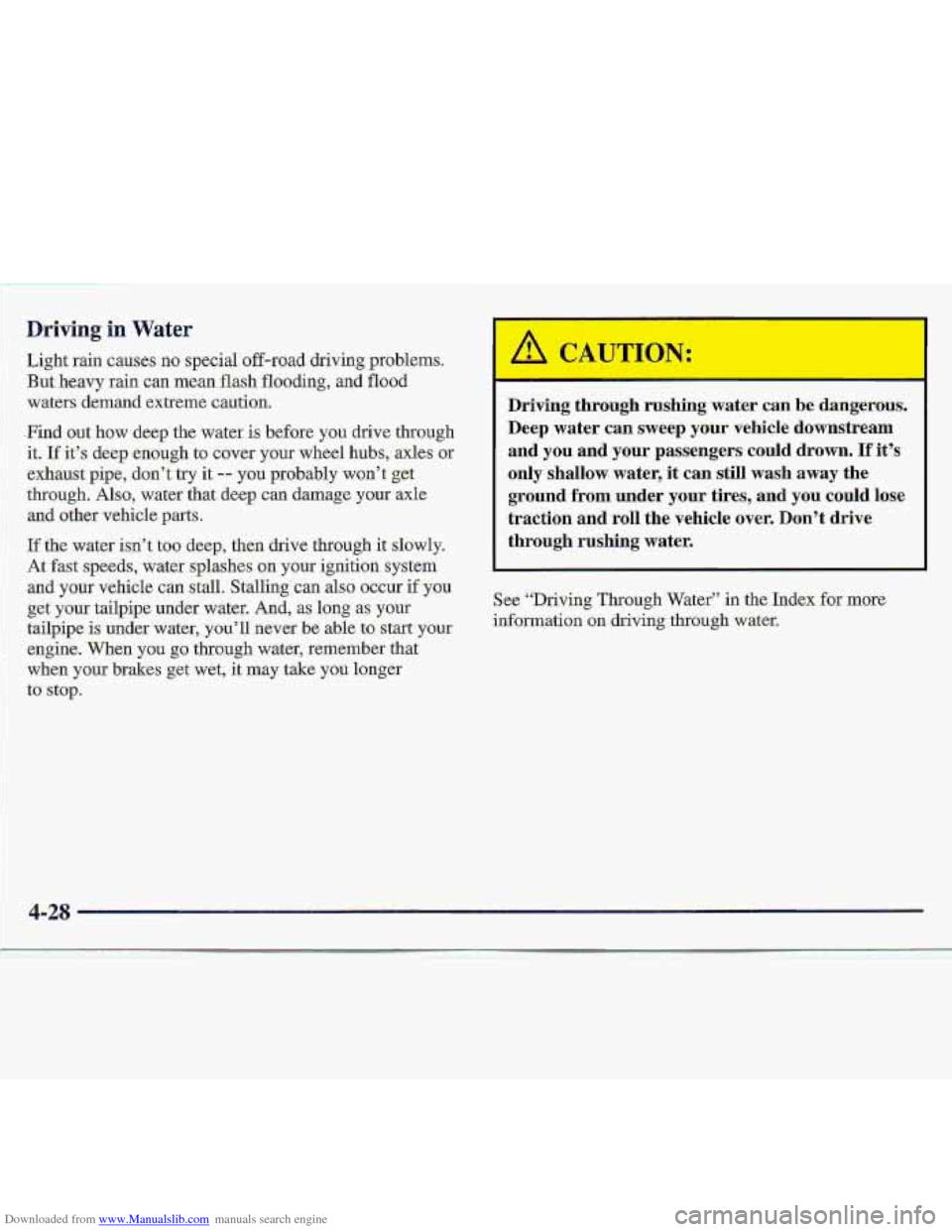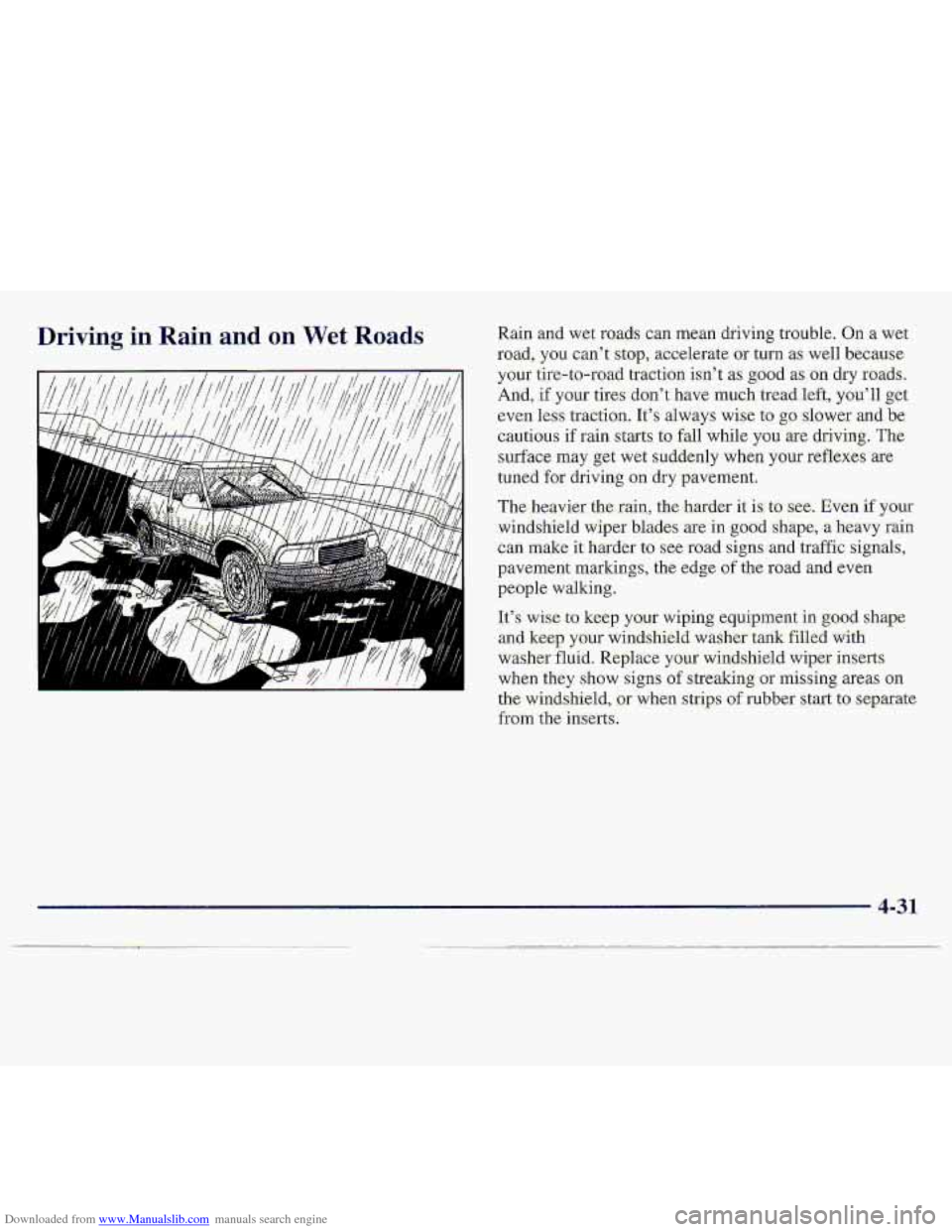stop start CHEVROLET S10 1997 2.G User Guide
[x] Cancel search | Manufacturer: CHEVROLET, Model Year: 1997, Model line: S10, Model: CHEVROLET S10 1997 2.GPages: 402, PDF Size: 21.04 MB
Page 165 of 402

Downloaded from www.Manualslib.com manuals search engine Driving in Water
Light rain causes no specialaff-road driving problems.
But .ke.avy rain
can .mean flash flooding, and flood
waters demand extreme caution.
+Find- out how deep the water is before you drive through
it. If it’s deep enough to cover your wheel hubs, axles or
exhaust pipe, don’t
‘try it -- you probably won’t g-et
through. Also, water that deep
can damage your axle
and
other vehicle parts.
If the water isn’t too deep, then drive through it slowly.
At fast speeds, water splashes on your ignition system
and your vehicle
can st-dl. Stalling.can also occur if you
get your tailpipe under water. And, as long as your
:.. . tailpipe is ,under water, .you’ll never be able to start your
..;;&I
engine. When you gp through water, remember that
--.
. ,. , when your brakes get wet; it may take you longer
to stop. -‘a:i <,..,..?, ,
Driving through rushing water can be dangerous.
Deep water can
sweep your vehicle downstream
and you
and your passengers could drown. If it’s
only shallow water,
it can still wash away the
ground
from under your tires, and you could lose
traction and roIl the vehicle over.
Don’t drive
through
rushing water.
See “Driving Throagh Water” in the Index f6TmGE
infoination on driving through water,
4-28
Page 168 of 402

Downloaded from www.Manualslib.com manuals search engine D-riving in Rain and on Wet Roa ; Rain and wet roads can mean driving trouble. On a wet
-road,
you can’t stop, accelerate or turn as well because
your fire-to-road traction isn’t as good.
as on dry roads.
Arid, if your tires don’t- have much tread
.left, you-’11 get
even less traction. It’-s alway,s wise to go :slower and.be.
cautious
if rain starts to fall while you are driving. The-
surface may get wet suddenly when your reflexes are
tuned for driving o,n dry pavement.
The heavier the rain, the harder it is: to see. Even if your
.windshield wiper blades
are in good shape, a heavy rain
can make it harder
to see road signs and traffic signals,
pavernent.maskings, the
edge sf the road and even
people walking.
It’s wise
to ke,ep your wiping equipment-in gaod shape
and keep your windshield washer tank-filled with
washer fluid. Replace
your windshield wiper inserts
when they show signs
of streaking or missing areas on
rhe windshieJd, or when strips of rubber start to sep-arate
from The inserts..
4-31
Page 193 of 402

Downloaded from www.Manualslib.com manuals search engine When. you tow a tixiilkr, y-our vehicle ha.s to’have extra
wiring :and a- heavy-duty turn signal flasher. (included in
the- optional trailering package).
The arrows-on your instrument panel will flash
whenever.
you signal a turn 01- 1-me. change, Properly
hooked .up, the &&la lamps will also flash, telling other
drivers you’re
about to :turn, change lanes or stop.
When towing a:txailer,
the. arrows. on your hstrument
panel will flash for turm even if the bulbs on the trailer
are burned out. Thus, you may think drivers behind you
axe seeing your signal when they arenot. ICs important
to check. occasionally to.be sure- the trider bulbs are.
still working.
Driving On .Grades
Reduce speed and shiftlo dower. ge.ar. ,befure you start
dawn B long -or steep downgrade. If-you do-n’t shift
down,
you might have to use your brakes wmuch that
they would
get hot and no longer work weIl.
If you have an.aut~~atic-transm~ssion, you should use
DRIVE (D) when towing a trailer. Operating your
vehicle in DRIVE @) when towing a. trail& will
Mze: heat:buiidup and merid the life af y.our
transmissioil. Qr, if you have, a-manu-ai transmission,
it’s
better not to use FIFTH (S), just drive in FOURTH (4)
(or, as you need to, a lower gew).
4-56
Page 195 of 402

Downloaded from www.Manualslib.com manuals search engine When You Are Re.ady .to Leave After
Parking on a Hill
1. Apply your regular brakes and hold the pedal down
while you:
Start your engine;
s.hift; int,o a.gear; and
.i Release tfie parking brake.
2. Let up dn the brake pedal.
3. .Drive slowly until the trailer- is ele-ar of-the chocks.
4. .Stop. and have someone pick up and store the chocks,
Maintenance W-hen Trailer Towing
Your vehicle will need service more. often when you're
-pullilig'.a trailer. Swthe Maintenance Schedule 'for more
on this. Things. that ar.e e.specizrlly import,at in trailer
operation
-axe automatic trmsrnission.fluid (don't
overfill),
engjne oil, axle lubricant, belt, cooling system
and brake adjustment.
Each of these is covered in this
manual, and the
Tndex- will help you find them. quickly.
If you're traileriqg, i-t's a go0.d i,dea to review these
sections before you start ,your trip ...
Check periodicailp t6 see-.th-at all hitch nuts and bolts
are -tight.
Trailer Wiring Harness,
'The -eight-wire harness is: stored under ysur vehicle
along the
rear frame crossmember. This hamess has a
30-amp feed wire with an inline fuse located by the
.junction block. It has no.cmnecttor .and should he. wired
by a qualified electrical technician. T.he .technician can
use the fullowing c~lor:c.ode chart when connecting the
-wiring harness IO yow trailer:
0
a
a
0
0
0
a
a